Improvement In The Technology For Using Conventional Sources Of Energy
Source Of Energy of Class 10
Improvement In The Technology For Using Conventional Sources Of Energy
BIOMASS AND BIO ENERGY:
If we can ensure that enough trees are planted, a continuous supply of fire-wood can be assured. Even the cow-dung cake serves as a fuel. These fuels called biomass are plant and animal products.
Biomass as a fuel
Biomass is an important source of energy (bio-energy). There are many ways in which biomass can be used as a fuel. However traditional use of these biomass has many disadvantages.
(i) Traditional use of biomass
The use is:
The simplest way of using biomass is to allow it to dry out in the sun and burn it.
(ii) Disadvantages of traditional use of biomass
(a) The calorific value of these fuels is low.
(b) They produce a lot of smoke and some harmful gases when they are burnt.
Improvement in technology
This has resulted in using the conventional sources of energy more efficiently such as:
(a) Fermentation of biomass produces ethanol which is a potential substitute for petrol and diesel.
(b) Charcoal formation where wood is burnt in unlimited supply of oxygen, water and volatile materials present in it get removed. Charcoal burns without flames, is comparatively smokeless and has higher heat generation efficiency.
(c) Coke is produced when coal is subjected to destructive distillation (i.e., heating strongly in the absence of air), which is a better fuel than coal as it does not produce smoke on burning.
(d) Anaerobic digestion of biomass produces biogas.
Biogas :
The decomposition which takes place in the absence of oxygen is called anaerobic degradation. Anaerobic degradation is carried out by anaerobic bacteria. Biogas is a mixture of methane, carbon dioxide, hydrogen and hydrogen sulphide. The major constituents of biogas is methane. Biogas is produced by the anaerobic degradation of animal wastes like animal dung in the presence of water.
Biogas Plant :
Biogas is prepared by anaerobic degradation of animal wastes like cow dung in biogas plant. The two types of biogas plant are :
(i) Floating gas holder type biogas plant.
(ii) Fixed-dome type bio-gas plant.
The raw material used for producing biogas in both the plants is the same, it is a mixture of cattle dung and water.
Floating gas holder type bio-gas plant:
This biogas plant consist of a well shaped underground tank called digester, which is made up of bricks. A drum shaped gas holder made of steel floats in the inverted position over the dung slurry in the digester tank. Since the gas holder floats over the dung-slurry, so this biogas plant is called floating gas-holder type biogas plant. The gas holder can move up and down, and its movement is controlled by the control pipe. There is a gas outlet at the top of the gas holder tank having a valve. A partition wall divides the digester tank in two parts: on the left of the digester tank is an inlet pipe made of cement (the inlet is connected to a mixing tank, on the right side of the digester tank is an outlet pipe, also made of cement, which is connected to an over-flowtank. The inlet pipe is for feeding the fresh dung slurry into the digester tank whereas the outlet pipe is for removing the spent dung after the extraction of biogas. Cattle dung and water are mixed in equal proportions in the mixing tank to prepare the slurry. This slurry of dung and water is fed into the digester tank through the inlet pipe. The dung undergoes anaerobic degradation in the presence of water with the gradual evolution of biogas. As more and more bio-gas collects in the gas-holder, the pressure of gas in it increases. As the spent dung slurry goes out, more fresh dung slurry is added to the digester tank on daily basis.
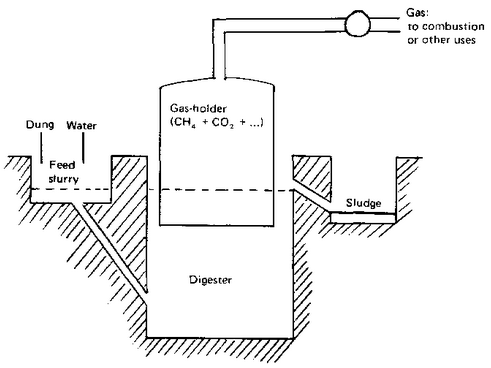
If any students need to take the online test to check their concepts or undertstanding then they can visit Quiz for Source of Energy.
Fixed dome type biogas plant:
This biogas plant is a dome-like structure built with bricks and consists of the following parts:
- Mixing tank: It is a tank where the slurry (semi fluid mixture) of animal dung and other waste materials is prepared by mixing it with an equal amount of water.
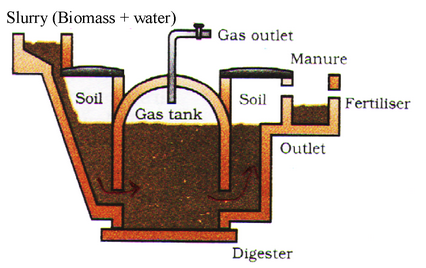
Schematic diagram of a bio-gas plant
Digester tank: The slurry so prepared is fed into the digester tank through an inlet chamber. The digester is a sealed chamber with no oxygen. The anaerobic microbes decompose complex compounds of the slurry within few days (50-60 days) and produce biogas.
- The biogas keeps collecting in the dome. It exerts pressure on the slurry in the digester tank which forces the spent slurry into the overflow tank through an outlet chamber.
- To get a continuous supply of biogas, fresh slurry is periodically added to replace the spent slurry.
Composition and advantages of biogas:
Biogas in mainly composed of methane (upto 75%), CO2 (25%) and traces of other gases such as nitrogen, hydrogen sulphide and hydrogen. The advantages are as follows:
- Biogas is a clean fuel that burns without smoke and leaves no ash like in wood, charcoal and coal burning.
- The main constituent of biogas, i.e., methane has a higher calorific value than that of petrol.
- The spent slurry being rich in nitrogen and phosphorus is good manure.
- By using biogas, firewood is saved and deforestation is reduced.
- The large-scale utilization of bio-waste and sewage material provides a safe and efficient method of waste-disposal besides supplying energy and manure.
Students can also get the CBSE Important Questions for class 10 Science Chapter Source of Energy from here.
WIND ENERGY:
Moving air is called wind. As the moving objects possess K.E. and as such they are capable of doing mechanical work by virtue of its motion. Wind also possess the ability of performing mechanical work because it is air in motion. So wind energy is the K.E. associated with large mass of air by virtue of its motion.
Solar energy is responsible for the blowing of air.
This can be explained as follows: The sunrays fall on the earth but the intensity of sun-rays is much stronger near the equator than in the polar regions. Due to more intense sun-light, the air near the surface of earth in equitorial regions becomes quite hot. This hot air, being lighter, rises upwards. The cooler air from the polar regions of the earth start flowing towards the equitorial regions of the earth to fill the space vacant by the hot rising air. In this way air flows from the higher pressure regions to the lower pressure regions of the earth. This flow of air from one place to another constitutes wind.
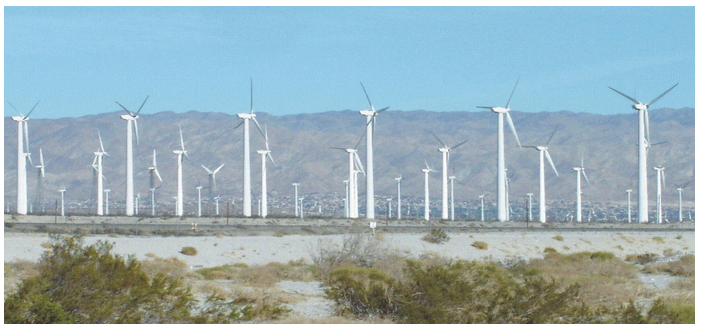
Wind energy farm
Advantages of Wind Energy :
(i) Use of wind energy does not lead to pollution.
(ii) Wind energy is available free of cost.
(iii) The source of wind energy i.e. air is an inexhaustible and reversible source.
Disadvantages of Wind Energy :
(i) One of the most important limitation of wind energy is that it may not be available at all times.
(ii) The windmill and sail-boats remain un-operational and no useful work can be done unless there is a plenty of fast blowing wind.
(iii) The speed of the wind at a place varies with time and season.
(iv) The K.E. of the wind can be utilized only at the site.
(v) There is no guarantee that we will get wind energy when required, since there is no place in the world where wind blows all the time.
(vi) The wind is not predictable.
(c) Practical Devices Making use of Wind Energy:
Wind mill:
A windmill is a machine, which works with the energy of blowing air or wind. It consists of large blades to catch the wind. When the wind strikes against these blades, they start rotating. The motion can then be passed on the other connected parts & is used to do useful work. A windmill consists of a system of big blades (or vanes) capable of rotating about a horizontal axis. The system of vanes is mounted on the top of a high tower. Its working is based on the tansformation of K.E. of wind into the rotational energy of the blade. The system of blades is connected to one end of the rod called shaft. The other end of the shaft is connected to a pump rod in case of water pump. This end is bent in form of inverted V and is connected to the free end of the pump rod of the water pump. When the wind blows, it rotates the blades of the windmill. The shaft turring about its axis rotates the crank. The rotation of the crank moves the piston rod of the water pump up and down & draws water from the well.
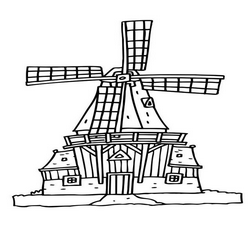
Windmill to operate flourmill :
It is similar to one used to grind grains by suitable arrangements of toothed wheel & shafts. The other end of the shaft is connected to a toothed wheel. Grinding arrangement of flour mill has a fixed mill stone A and another heavy mill stone B. B is capable of rotating by a shaft rod (W2) having a toothed wheel (W2). The wheel (W1) is coupled with the wheel (W2) such that the rotation of wheel (W1) about a horizontal axis rotates the wheel (W2) about a vertical axis. The wheel (W1) rotates as the shaft (W1) connected to blades rotates due to rotation of blades of windmill. Thus the K.E. of wind by virtue of this motion rotates the windmill which in turn operates a flourmill and is able to grind grains.
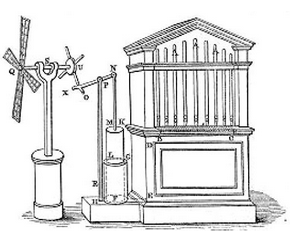
Wind generator:
A modern generator, which is used to generate electricity by using wind energy is wind generator. When the fast moving wind strikes the blades of wind turbine, then the wind turbine starts rotating continuously. The coil of a small electric generator is attached to the shaft of wind turbine. So when the wind starts rotating and generates electricity. The electricity generated by a single wind turbine is quite small. So, in order to generate a large amount of electricity, a large amount of wind turbines are placed over a big area of land. Such a set-up of having a large number of wind turbines working at a place to generate electrical energy on a large scale is called a wind energy farm.
- Introduction
- What Is A Good Source Of Energy?
- Classification Of Source Of Energy
- Conventional Sources Of Energy
- Improvement In The Technology For Using Conventional Sources Of Energy
- Alternative Or Non-Conventional Sources Of Energy
- Environmental Consequences Of Exploiting Sources Of Energy
- How Long Will An Energy Source Last Us?
- solved questions
- Exercise 1
- Exercise 2
- Exercise 3
- Exercise 4









